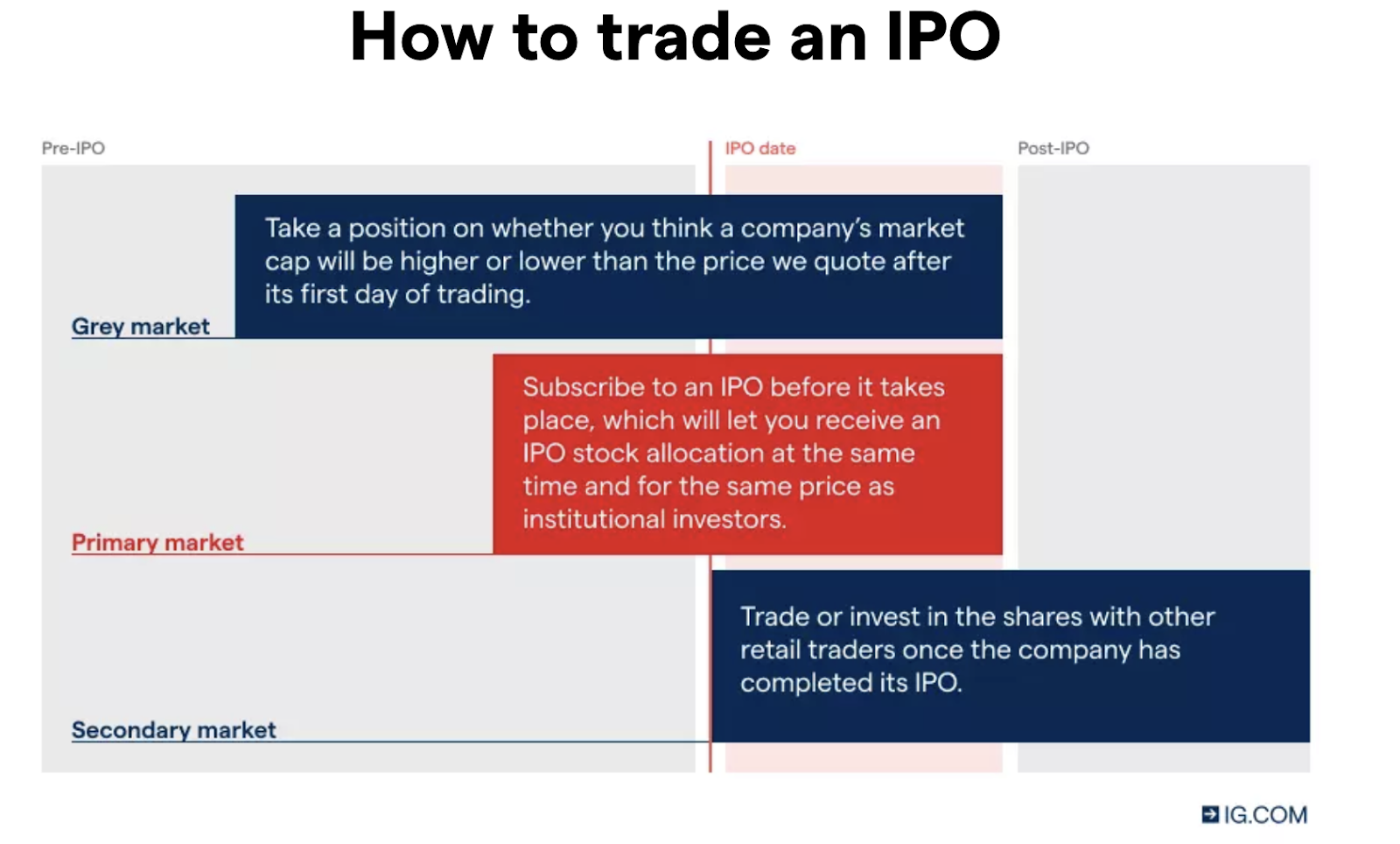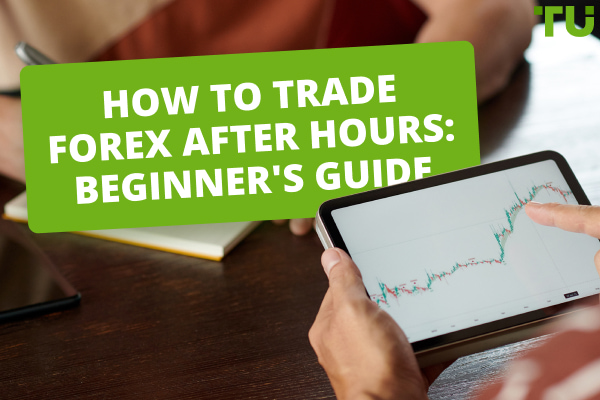Initial Public Offering Explained For Beginners

Top commission-free stock broker - eToro
An IPO, or Initial Public Offering, is the process through which a private company transitions to a public company by offering shares to the public for the first time. This allows the company to raise capital from investors in exchange for ownership stakes. It's a significant milestone for a company, as it opens up opportunities for growth and expansion by accessing the broader capital markets.
Have you ever heard of a company going public and wondered what it all means? This is where IPOs come in! An IPO, or Initial Public Offering, is a significant milestone for a company, marking its transition from private ownership to a publicly traded entity. By offering shares to the public for the first time, IPOs can be an early opportunity for investors, but they also come with inherent risks. In this review, the experts at TU have unlocked the secrets of IPOs, including how they work, the risks and rewards involved, and alternative ways to participate in a company's public debut.
-
Is IPO good or bad?
Whether an IPO is good or bad depends on various factors. It can offer opportunities for growth and investment, but it also carries risks. It's essential to research and consider your investment goals before deciding.
-
Who gets money from an IPO?
In an IPO, the money raised from selling shares primarily goes to the company issuing the IPO. This capital is typically used for growth initiatives, debt repayment, or other corporate purposes. As a rule, the revenue sharing scheme is approved by the company's management prior to the official announcement of the IPO.
-
Does every IPO give profit?
Not necessarily. While some IPOs can yield profits for investors, others may not perform as expected. The success of an IPO depends on factors like market conditions, company performance, and investor demand.
-
Is IPO better than stock?
Comparing an IPO to stocks is like comparing apples to oranges. An IPO marks a company's initial offering of shares to the public, while "stocks" refer to shares of publicly traded companies. Both have their own advantages and risks, and the suitability depends on individual investment goals and preferences.
IPO meaning
An Initial Public Offering (IPO) is when a private company becomes a public company by selling shares to the public for the first time. This helps the company raise money from people who want to invest. Before an IPO, the company is private and only a few people own shares. But with an IPO, the company can get a lot of money, which helps it grow bigger. To do an IPO, the company has to meet certain rules from organizations like the Securities and Exchange Commission (SEC). They also hire banks to help them sell the shares. The price and date of the IPO are set before it happens.
During an IPO, the people who own shares privately can sell them to the public. This lets them make money from their investments. People who buy shares during an IPO become part-owners of the company and help it by giving money. The price of the shares is decided by looking carefully at the company's worth. After the IPO, people can buy and sell shares at the price set during the IPO. So, an IPO is a big moment for a company because it changes from being owned by a few people to being owned by the public. It also gives both private and public investors a chance to be part of the company's growth.
Best brokers for IPO in 2024
Saxo Bank
The SaxoBank brokerage company was founded in 1992 under the original name Midas. In 2001, the broker was licensed by the FSA, a Danish Financial Supervisory Authority (1149). After that, the company changed its name to SaxoBank. Today the broker provides online access to various financial markets to clients from 170 countries. In 2017, the SaxoTraderGO terminal was recognized as the best trading platform for active trading according to FX Week’s e-FX Awards and ADVFN International Financial Awards. Can you trade options with Saxo Bank?
eToro
The eToro broker was founded in 2007. The company promotes itself as a social trading platform working with traders from over 140 countries. The broker has several divisions operating under different jurisdictions and licensed by different regulators. For example, eToro (Europe) is licensed by the Cypriot regulator CySEC (109/10) and eToro (UK) is licensed by the British regulator FCA (583263). The broker also has a representative office in Australia and the USA. eToro Profile Details
Interactive Brokers
Interactive Brokers is among the best-known US investment companies, operating since 1977. The broker offers to trade currency pairs, but its basic instruments are stocks, CFD, indices, metals, ETF, futures, and other exchange market assets. The company is regulated by the US Securities and Exchange Commission (SEC), the US Financial Industry Regulatory Authority (FINRA), the UK Financial Regulatory Authority (FCA, 208159), and other international financial regulation commissions. In 2020, the broker was awarded the "Best Online Broker” (Barron's) and "Best Broker for Economical Investments" (NerdWallet) titles and got five stars in the Online Stock Trading for Traders category (Canstar). Also, the broker is popular in other countries. Here you can read reviews of Interactive Brokers in Canada, Singapore, Australia, Hong Kong, Ireland.
Types of IPO
When it comes to Initial Public Offerings (IPOs), there are two main types: Fixed Price Offering and Book Building Offering.
In a Fixed Price Offering, the price of IPO shares is already decided before they are available to the public. Investors know the price beforehand because it's mentioned in a document called the prospectus. This method sets a specific price for shares, determined by the company and its financial advisors after looking at things like how much money the company has and its future plans. Investors pay this fixed price when they buy shares, and we only know how many people want shares after the offer is closed. This type is simpler because investors know the price upfront.
Advantages of Fixed Price Offering:
-
Simpler and faster process.
-
Certainty for investors regarding the share price.
-
Fairness for all investors regardless of their investment size.
On the other hand, in a Book Building Offering, the share price isn't set initially. Instead, it's decided based on the bids from investors during the IPO period. The company sets a price range, with a minimum and maximum price. Investors then bid for shares within this range. The final price is figured out based on these bids, which helps to find the best price. Investors only know the actual share price after the bidding closes. This method is more flexible and helps to match supply with demand better.
Advantages of Book Building Offering:
-
Potential for a higher IPO price if there's strong investor demand.
-
More accurate price discovery based on investor bids.
-
Targeted allocation to specific investor categories.
The main differences between the two types are in how the price is set, when we know how many people want shares, and how the payment works. In Fixed Price Offerings, the price is already set, and we only know the demand after it closes. Investors pay everything upfront. In Book Building Offerings, the price is decided after collecting bids, and demand can be assessed daily. Payment is made after the shares are given out. Additionally, allocations in Fixed Price Offerings are based on investment levels, while in Book Building Offerings, allocations are reserved for different types of investors, like small investors or big institutions.
Choosing the right offering type:
The choice between fixed price and book building offering depends on factors such as market conditions, investor base, and company goals. For stability in a volatile market, a fixed price offering might be preferred. Even if the company aims to attract a large number of retail investors, a fixed price offering could be more suitable. On the other hand, if maximizing capital raised is the goal, a book building offering might be preferable.
Why and how do companies go public?
Here are the key reasons on why companies decide to go public:
Raise capital
TU expert Mikhail Vnuchkov suggests that one of the main reasons companies go public is to get a lot of money from the public. This money helps them grow bigger by funding things like expanding their business, doing research, or buying other companies.
Liquidity for investors
When a company goes public, it means that people who invested in the company early on can sell their shares on the stock exchange and get their money back. This gives them a way to turn their investment into cash.
Increased credibility & brand awareness
Going public can make a company more famous and trusted. Being listed on the stock exchange brings a lot of attention from the media and makes the company look more established and reliable.
Employee stock options
Publicly traded companies can offer their employees stock options, which means they can buy shares in the company as part of their pay. This helps attract and keep talented employees.
To understand how companies decide to go public, it's important to look at the steps involved in an Initial Public Offering (IPO):
Decision to go public
Companies decide to go public to get money, give investors a way to sell their shares, become more well-known, and make their brand stronger.
Selecting a lead underwriter
The company picks a bank or financial institution to help with the IPO process, do research, and decide on the IPO price.
Kick-off meeting
A meeting starts the IPO process, where everyone involved talks about what they need to do and when they need to do it.
Submission of IPO filing documents to the SEC
The company sends important papers to the Securities and Exchange Commission (SEC) for approval.
Red Herring
A document with key details about the IPO, called a red herring, is given to possible investors.
Roadshow
The company goes on a roadshow to talk to investors about the IPO, getting them interested and seeing how many shares they might want to buy.
IPO pricing
The final price of the shares is decided based on how much investors want them and what the market conditions are like.
Allocation of shares to investors
Shares are given to investors based on how much they want and how much they're willing to pay.
Commencement of Trading: The company's shares start being traded on the stock exchange, showing that it's now a public company.
Post-IPO management
After going public, the company has to follow rules, report regularly, and keep communicating with investors to make sure everything goes smoothly.
Each step in the IPO process is important for the company's success, involving careful planning, working with underwriters, following rules, deciding on prices, and talking to investors. Going public through an IPO is a big deal for companies that want to grow, get money, and become better known.
Why an IPO Lock-Up period is needed
The Lock-Up period is a special contractual provision that prohibits insiders and major participants from selling shares for a certain period of time after the IPO. There are no strict requirements, but it is usually at least 120-180 days.
Insiders are generally considered to be owners, managers, employees of the company, and large private, corporate, and venture capital investors, i.e., anyone who owns a disproportionately high percentage of the stock compared to the rest of the participants.
The SEC does not require a Lock-Up period; this fact is regulated by the company going public or the investment bank acting as a guarantor of the IPO filing.
Companies use this method to prevent insiders from flooding the market with shares. Massive sales can cause the stock price to plummet immediately after going public.Regular traders are advised to invest in newly listed companies only after the Lock-Up period has ended.
How to trade an IPO?
Pre-IPO market (Grey market)
In the pre-IPO market, often called the grey market, trading happens before a company's shares are officially listed on a stock exchange. Here, investors speculate on whether the company's stock will be worth more or less than the expected price after it goes public. While this market can offer potential profits, it's not regulated, meaning there's no guarantee of the transactions' legitimacy. Plus, finding buyers or sellers might be challenging when needed.
Primary market
The primary market lets you subscribe to an IPO before it happens. You express your interest in buying shares at the offering price. If your subscription is successful, you get shares at the same time and price as big investors like banks. But getting these shares can be tough, especially for popular IPOs.
Secondary market
The secondary market is the regular stock exchange where you can buy and sell shares after a company's IPO is finished. Once the company is listed, its shares can be traded like any other public stock. This way offers a more standard and regulated approach to participating in an IPO, even though the share price might have changed since the initial offering.

Is investing in IPO a good or bad idea?
Pros
Potential for high returns
Investing in an IPO offers the potential for significant gains if the company performs well in the stock market. If you get in early on a promising company, the stock price could skyrocket, leading to substantial profits.
Chance to invest alongside big players
Participating in the primary market of an IPO allows individual investors to buy shares at the same price as big institutional investors like banks and hedge funds. This equal footing can provide opportunities for retail investors to make profitable investments.
Increased liquidity
When a company goes public, its shares become tradable on the stock exchange, providing investors with greater liquidity compared to private companies. This means investors can easily buy or sell shares, which can be advantageous for managing investment portfolios.
Enhanced credibility
A successful IPO can enhance a company's credibility and brand recognition. Being publicly traded can attract more investors, boost investor confidence, and improve the company's reputation, making it potentially more appealing for investment.
Cons
High risk, high reward
Investing in IPOs comes with inherent risks. The future performance of the company is uncertain, and the stock price could decline significantly after the offering. While there's potential for high returns, there's also a possibility of substantial losses.
Competition for allocations
Acquiring shares in the primary market of an IPO can be challenging, especially for popular offerings. Demand for shares may exceed supply, leading to competition among investors. This can result in some investors not getting the desired allocation of shares.
Hype and volatility
IPOs often generate a lot of hype, which can drive up share prices beyond the company's true value. This hype can create bubbles in the market, followed by corrections when the prices adjust. Additionally, the stock price may experience volatility in the period following the IPO, making it unpredictable for investors.
Limited information
Since newly public companies have limited historical data and financial information available to the public, assessing their true value and future prospects can be challenging. Investors may have to rely on incomplete information, increasing the uncertainty associated with investing in IPOs.
Are IPOs legal? IPO regulation explained
Yes, IPOs (Initial Public Offerings) are legal means by which companies raise capital from the public. However, they are subject to stringent regulations to ensure fairness, transparency, and investor protection. Let's explore the legalities of IPOs in various countries, including the United States, United Kingdom, Australia, India, and the European Union.
United States
In the US, the Securities and Exchange Commission (SEC) oversees IPO regulations. Companies must adhere to the Securities Act of 1933, which requires the registration of securities offered for public sale. This process involves submitting a detailed prospectus to the SEC, outlining financial information, business operations, risks, and future plans. The SEC reviews the prospectus carefully to ensure it provides accurate information for investors.
United Kingdom
The Financial Conduct Authority ( FCA) regulates IPOs in the UK. Companies wishing to list on the London Stock Exchange (LSE) must comply with the FCA's Listing Rules, similar to the regulations in the US. These rules mandate the preparation of a detailed prospectus for public distribution, adhering to the Prospectus Regulation requirements established by the European Union.
Australia
In Australia, the Australian Securities and Investments Commission (ASIC) oversees IPOs. Companies seeking listing on the Australian Securities Exchange (ASX) must follow the Corporations Act 2001 and the ASIC Act 2001. They must prepare a detailed prospectus, which is reviewed by ASIC, ensuring compliance with the Corporations Act's disclosure obligations.
India
The Securities and Exchange Board of India (SEBI) regulates IPOs in India. Companies planning to list on the Bombay Stock Exchange (BSE) or the National Stock Exchange of India (NSE) must comply with the Companies Act, 2013, and the SEBI (Issue of Capital) Regulations, 2018. They submit a draft Red Herring Prospectus (DRHP) to SEBI for approval, detailing financials, business plans, and risks.
European Union
The EU has a harmonized regulatory framework for IPOs through the Prospectus Regulation. Companies seeking listing within the EU can prepare a single prospectus compliant with the regulation. This prospectus undergoes review by the national competent authority (NCA) and facilitates a faster listing process across member states.
How is IPO risky?
IPOs may seem tempting for investors, offering the chance for big profits. However, they also come with certain risks that need to be understood and managed before jumping in. Here's a closer look at the main risks associated with IPOs:
Limited track record
Newly public companies often lack a long history of financial performance, making it hard to predict how they will do in the future. Without a proven track record, assessing their potential profitability and success can be challenging.
Hype and overvaluation
IPOs can generate a lot of excitement, leading to inflated share prices that may not accurately reflect the company's true value. This hype can create a bubble that bursts after the IPO, causing the stock price to drop significantly.
Information difference
Since IPO companies are new to the public market, there may be limited information available to investors compared to more established companies. This makes it difficult for investors to fully understand the risks and rewards of investing in the IPO.
Lock-up periods
After an IPO, insiders like founders and major shareholders may have to wait for a set period before they can sell their shares. Once this lock-up period ends, a large number of shares entering the market at once can drive the stock price down.
Volatility
IPO stocks are often more volatile than those of established companies. The period immediately after the IPO can be particularly unstable, with big swings in the stock price as investors try to figure out its true value.
Strategies to mitigate IPO risks:
Conduct thorough research
Take your time to research the company's financials, business model, management team, and plans for the future. Look closely at the prospectus for any warning signs before investing.
Focus on fundamentals
Don't get caught up in the excitement surrounding the IPO. Focus on the company's long-term potential, such as its growth prospects and competitive advantages, rather than short-term hype.
Invest for the long term:
Consider investing in IPOs with a long-term perspective. Give the company time to execute its plans and for the stock price to reach its full potential value.
Start small
If you're unsure about an IPO, consider investing a smaller portion of your portfolio. This way, you limit your losses if the stock price doesn't perform as expected.
Diversify
Spread your investments across different asset classes and companies to reduce risk. Consider including established companies alongside IPOs for a well-rounded portfolio.
Are IPO stocks good investments?
IPO (Initial Public Offering) stocks may seem attractive to investors, offering the opportunity to invest early in a promising company and potentially gain significant profits. Despite the exciting nature of it, investing in IPOs comes with risks, but historical success stories highlight their potential rewards. While there's no surefire way to riches, some IPOs have provided substantial returns to investors. Consider these examples:
-
Facebook (FB): Facebook's IPO in 2012 priced shares at $38, and they have since soared to over $300, marking a remarkable 797.42% increase.
-
Google (GOOG): Google's IPO in 2004 priced shares at $85. Today, they trade above $2,800, showcasing a staggering 3,287.59% return.
-
Amazon (AMZN): Amazon's IPO in 1997 offered shares at $18. Presently, the stock price is around $3,400, indicating an astounding 189,573.9% growth.
While these success stories are impressive, they represent only a few cases. For every triumphant IPO, many others fail to meet expectations, leading to potential declines in stock prices. Predicting which IPOs will flourish and which will flounder is challenging. Although some studies suggest that IPO stocks may outperform the broader market in the short term, this advantage may diminish over time.
-
Renaissance Capital Research tracks IPO performance globally and found that from 1999 to 2022, US IPOs returned an average of 18.6% in the first six months after listing, compared to the S&P 500's 10.5% return during the same period.
-
JPMorgan Chase analyzed IPO data from 1975 to 2017 and discovered that IPOs tend to underperform the S&P 500 by an average of 3.8% over the long term (five to ten years).
IPO Alternatives
While the standard Initial Public Offering (IPO) has long been the traditional method for companies to enter the public markets, new alternatives have emerged, presenting different ways for companies to achieve this goal. Here are some of these alternatives:
Direct listings
Direct listings offer companies a route to go public without issuing new shares or raising capital. Instead, existing shares are listed on a stock exchange, allowing shareholders to sell their shares directly to the public. This approach offers liquidity for existing shareholders and can be more cost-effective compared to a traditional IPO.
Special Purpose Acquisition Companies (SPACs)
SPACs are essentially empty companies created with the sole purpose of acquiring or merging with a private company to take it public. SPACs raise funds through an IPO and then hunt for a suitable private company to merge with, providing a quicker and less conventional pathway to becoming a publicly traded company.
Direct Listings with Primary Offerings (DLPOs)
DLPOs blend elements of both direct listings and traditional IPOs. In this approach, companies can go public, list existing shares, and simultaneously offer new shares. This allows companies to benefit from the advantages of a direct listing while also raising capital through the sale of new shares.
How much money is needed to apply for an IPO?
The funds required to apply for an IPO in the USA can vary widely depending on the particular IPO and the brokerage or platform through which you're participating. There's no fixed amount as it hinges on factors like:
Trading strategy
Different trading strategies come with different capital needs. Day trading, swing trading, and position trading all have distinct approaches that might demand varying initial investment amounts.
Risk tolerance
Your risk tolerance is crucial in determining how much capital you should allocate to trading. Riskier strategies might necessitate more capital to withstand market fluctuations.
Financial goals
Your financial goals will impact the amount needed to start trading. Whether you're aiming for short-term gains or long-term growth will affect your initial investment decisions.
Market conditions
The state of the market and the volatility of assets can influence the amount required to trade effectively. More volatile markets may call for a larger initial investment to manage risks.
Trading platform
The trading platform or exchange you select could have minimum trade requirements or fees that can impact the amount needed to initiate trading.
Team that worked on the article
Chinmay Soni is a financial analyst with more than 5 years of experience in working with stocks, Forex, derivatives, and other assets. As a founder of a boutique research firm and an active researcher, he covers various industries and fields, providing insights backed by statistical data. He is also an educator in the field of finance and technology.
As an author for Traders Union, he contributes his deep analytical insights on various topics, taking into account various aspects.
Dr. BJ Johnson is a PhD in English Language and an editor with over 15 years of experience. He earned his degree in English Language in the U.S and the UK. In 2020, Dr. Johnson joined the Traders Union team. Since then, he has created over 100 exclusive articles and edited over 300 articles of other authors.
The topics he covers include trading signals, cryptocurrencies, Forex brokers, stock brokers, expert advisors, binary options. He has also worked on the ratings of brokers and many other materials.
Dr. BJ Johnson’s motto: It always seems impossible until it’s done. You can do it.
Mirjan Hipolito is a journalist and news editor at Traders Union. She is an expert crypto writer with five years of experience in the financial markets. Her specialties are daily market news, price predictions, and Initial Coin Offerings (ICO). Mirjan is a cryptocurrency and stock trader. This deep understanding of the finance sector allows her to create informative and engaging content that helps readers easily navigate the complexities of the crypto world.












